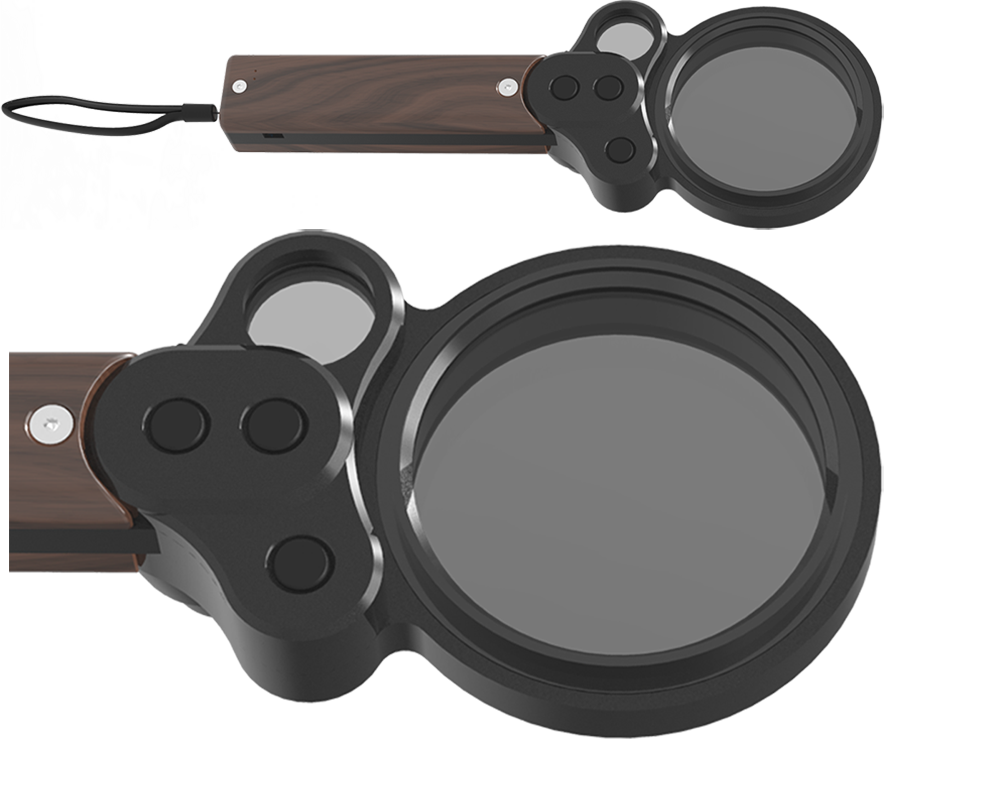The Inspector is a high-tech instrument for inspecting and appraising artefacts. It is based on our X-polar technology for observing the true colors of the artifact, and for studying details like signatures with much more contrast and definition.
The Inspector
€1,149.50 (ex. VAT €950.00)
Description
Our first product on the market is the InSpector: a high-tech instrument for inspecting and appraising artefacts. It is based on our X-polar technology for observing the true colors of the artifact, and for studying details like signatures with much more contrast and definition.
Besides the X-polar vision, the InSpector also provides a strong and very pure UV beam, for detecting all kinds of materials like varnish, glue, metals and plastics. Finally it contains a high quality jewelers’ loupe for close inspection, with a soft white lighting. The body is made of aluminium, provided with an oiled hardwood handle.
pecifications
General
Purpose: high-end instrument for inspecting and appraising artefacts.
Technologies incorporated:
X-polar vision technology for observing the true colors of the artifact, and for studying details like signatures with much more contrast and definition. The image is seen through a 77mm +2D lens. Lighting by a 5W (CCT4000 – 4500) LED
UV beam (395 nm, narrow spectrum) for clearly detecting all kinds of materials like varnish, glue, metals and plastics. For safety reasons, it takes one second for the UV beam to reach full intensity.
Jeweler’s loupe for close inspection at 5cm, with a soft white lighting assist. (26mm +10D achromatic doublet lens)
Caution!: The strong UV LED is potentially blinding and should never be looked into, or be pointed at anyone’s eyes!
Accessories
Wrist band
2 lense caps
Traveling casing with foam inlay
USB loading cable (standard micro-USB)
Not included: USB net loader
Guarantee
5 years on LEDs and electronics
3 years on battery
Technical Specifications
Weight: 465gr
Size InSpector: 250x90x55mm
Size Casing: 320x220x70mm
Body: Milled aluminium parts, anodized, and lacquered in transparent varnish
Handle: Oiled Santos Pallisander hard wood
Lenses: 77mm +2D glass 24mm +10D glass
LEDs: White (CCT 4000 – 4500) 5W, max 1 hour 30 minutes per battery load UV (395nm) 3W, max 2 hours 20 minutes per battery load White (soft) 0,05W max 150 hours per battery load
Power system: Constant stabile voltage for all three LEDs independently during whole battery depletion period (on-board multiple buck-boost converter)
Battery: Li-Ion 3,7V, 2900 mAh, > 500 load cycles expected under normal circumstances Protected against overheating, over charge, over discharge, over current and short-circuit.
Charging: Through USB micro cable, app 5 hours at 500 mA
Charge controller: Dedicated Li-Ion low current charge control, for long battery life
General charging advice: Charging the InSpector in a below zero ( C ) temperature environment will seriously shorten battery life (f.i. loading in a parked car in winter) Storing it at an elevated temperature (over 35C) can also damage your battery (f.i. in a parked car in summer). Recharging a partially discharged battery quite often is not causing permanent capacity loss, as long as a full discharge and charge cycle is performed once in every 25 cycles. Do not leave the battery fully unloaded for a long time (several weeks)
Advanced charging advice: Not fully charging the battery increases battery life. It is advised to only fully charge if an intensive use is expected that day. For long periods (several months) of storage, it is best not to have the battery fully loaded, but only half. This can be achieved by charging only one hour from fully discharged. Li-Ion batteries have a very low self-discharge, but a few percent of discharge per month can occur, even more when fully loaded and stored at an elevated temperature (f.i. cars in summer).
Manual
INTRODUCTION
The Inspector M1 is a versatile loupe designed to be used to inspect a wide range of materials in the field of art, antiques and artefacts.
Lion Optics worked in collaboration with art dealers, museums and restoration specialists to adapt this tool to their specific needs. After many hours of testing on real examples in the field, Lion Optics has been able to exactly tailor the Inspector M1 to reach a perfect output of polarised and UV light. This combination allows a perfect scan of a large scope of artworks and gives a better understanding of their conditions. Other variables will have an effect on what you can see using the crossed polarised function of the device. We are still discovering that the Inspector can provide better vision on a new range of materials.
The Inspector M1 specifications
The Inspector M1 is equipped with two adjustable polarisers that allow modification or elimination of reflected light. To maximise its performance, the loupe also features a UV light and a doublet eye-loupe. Its fully rechargeable battery allows for cordless operation.
1. Polariser function
Many light sources – including the sun – emit a large number of photons of light that are oriented in all directions. These photons are a mixture of lightwaves, travelling in all possible transverse directions. When light waves hit a reflective surface, the light reflected becomes polarised. This reflection is a lightwave travelling in one direction.
A polariser can filter this reflected polarised light by absorbing or reducing the glare reflected from a shiny surface, such as varnish on a painting, for example,. This allows the natural colour and detail of the subsurface to appear. The Inspectors polarised light penetrates deeper in the surface of different materials, while non-polarised light provides information about the superficial surface layer. The M1 allows the user to get more information about the specimen by toggling between the two polariser modes.
Using the Inspector M1 polariser function with paintings
A painting consists of various layers: the white base, the paint pigments and the varnish. The varnish reflects more light than the pigments underneath, which significantly interferes with the light reflected by the pigments. Likewise, when examining thin sections of paintings destroyed by over-cleaning, the white of the base layer will reflect more light than the paint pigments. The M1 can reduce those highly polarised reflections to allow the unpolarised rays reflected by the pigments to be revealed.
The Inspector M1 features :
One Polariser filter: this filter can be manually rotated and is placed in front of the strong led illuminator. Consequently, it only allows light waves vibrating along their polarising axis to completely pass through, while absorbing light waves that move in other directions.
One Analyser filter: this additional large polariser is placed underneath the magnifier and allows to see through. The object observed lies in the light path between the two filters.
When the two polarisers are crossed, very little reflective light passes through the loupe. However, you can always adjust the amount of light waves during inspection by rotating one of the polarisers.
The Inspector M1 offers more contrast, true colours and eliminates reflections on most materials.
How to use your polarizer function
Hold the magnifier directly above the object you would like to examine. The focal length is approximately 20 cm from the object. The ideal distance to the eyes is about the same but adjust to your own preferences. For best conditions, the amount of ambient light should be dimmed so as to not to overpower the polarised light. Complete darkness is not necessary but this would give the best results. By slowly rotating the ring of one of the polarisers the reflections will disappear to reveal the true nature of the specimen.
Polarised light is completely harmless to artwork or delicate materials.
2. UV light
The ultraviolet emitter is essential when evaluating artwork for their condition and age. The UV led emits an ultraviolet light wave of 365 nanometers. At this wavelength, many materials absorb invisible ultraviolet energy and transform this energy into visible coloured light, easily distinguished by the human eye. This makes the ultraviolet light an especially useful instrument when checking the condition of any kind of artwork. Prior restorations can easily be detected.
How to use your UV light function
In a darkened environment, ultraviolet light reveals alterations such as layers of paint, repairs and floating signatures on artwork that are normally invisible in daylight. The slightest alteration will stand out with extreme clarity under UV light.
CAUTION:
The strong UV LED is potentially blinding and should never be looked into, or be pointed at anyone’s eyes!
Always keep the InSpector away from children!
3. Jewellery Magnifying Loupe
This doublet lens is the third function and allows the user to examine materials or small objects at a very close distance to the eye, making the object appear larger and revealing details not perceivable by the naked eye.
How to use your doublet lens function
The best way to use this function is to hold the small magnifier as close to the eye as possible while bringing the subject closer to the lens until it comes into focus (app. 7cm). Press the button in the middle to illuminate the object you want to examine through the eye loupe.





